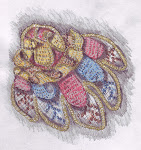Split Stitch closer analysis
When we visited Florence and I saw historical vestments, especially on the top floor of a particular duomo where they are on permanent display, I could see why the little faces on Opus Anglicanum were stitched in circular formation for convex areas such as cheeks. If you behold them from the side they glow. I think I mentioned at the time.
So, obviously finding a way to make very small faces appear resplendent to the congregation was massively important, especially when most people could not read and so needed to be awestruck by graphical representation. All the spiritual impact that could, had to be stitched into those tiny faces and hands, because to see them, you would be humbled and soon after it follows, you would hopefully experience a feeling of renewed faith, especially with representations of saints and angels and later, Pie Jesu himself.
Ok, so how on earth did they do it?
First off, forget cotton, you need silk. Only silk will reflect the light off the little cheeks, heads and minuscule chins. Also the silk you use has to be flat. If it’s twisted, untwist it and use only one strand.
Then the next problem is Split Stitch itself
If you’ve ever tried modern split stitch, you’ll know it must have taken them forever if that’s how they used to work.
We already know that ‘forever’ in a religious order is a relatively short time, one could say. Because while you’re waiting for the ‘second coming’ you have all the patience in the world.
But, what about when your more immediate ‘employer’ is waiting for a shipment, can stitches really take ‘forever’ in that set up? I suspect the answer to that is no.
Then you factor in the time value of money, big money...
My view is this. Old nuns with poor eyesight were employed to stitch, as well as young ones with 20:20 vision. So if the stitch ‘took forever’ the older nuns would be redundant - methinks not.
Anyone that has spent their life sewing, was never going to be retired.
Ok, so your Order lives in a convent on a hill and you can make 20 little faces in 6 months. Your main customer is an Italian Bishop and you tell him the vestments he wants will take 7 years.
How do you eat as a cloistered congregation till then?
Yes, they grew vegetables etc but my view is, they worked to output, they worked and worked and achieved wealth for their dioceses.
This leads me to conclude: I think they produced split stitch in a much faster way: as a variety of Back Stitch, much like Stem Stitch can also be described in this way. And in so doing, they were able to sew many more little faces.
So
In revisiting Split Stitch, I pulled out my research notes from last time and picked up where I left off. It doesn’t matter to me that I didn’t spend months and months on the problem, all I needed was to zone in and when so doing I will only trust one thing, well two really but the other is private. The one thing I trust for you to know, is my own eyeballs.
My own eyes tell me that in this piece:
There are at least four different ways to work split stitch. Furthermore, split stitch really is only trying to be the finest possible Chain Stitch.
But then I further discovered, after about 4 hours of thrashing it out, that you cannot possibly make tiny spirals out of Modern Split Stitch and have the stitches crammed in as we so often see, because there isn’t enough room to manoeuvre the needle. But YOU CAN work super tight spirals if you complete the work as a Back Split Stitch where you pierce the previous stitch in a downward action. This means you can see exactly where to go and it saves a whole heap of hit or miss.
Comments most welcome.
I think I need to do another YouTube video....
Subscribe to:
Post Comments (Atom)






















Clever!
ReplyDelete